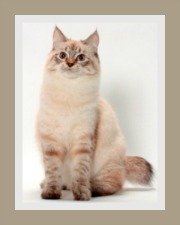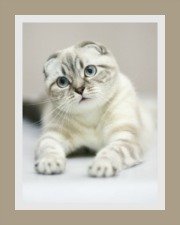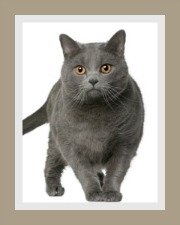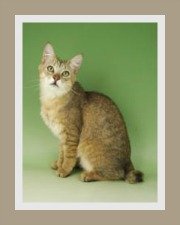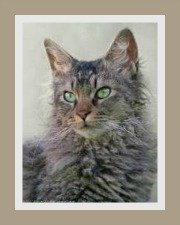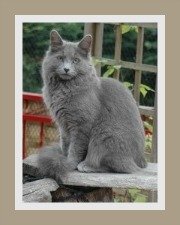Chartreux
Cat Facts and Breed Profile
The Chartreux is one of three blue cat breeds. The three breeds originate from different parts of the world and are not the same cat breed.
The Korat and Russian Blue cats are the two other natural breeds of blue cats. The British Blue is not a separate breed, but rather a color variant of the British Shorthair.
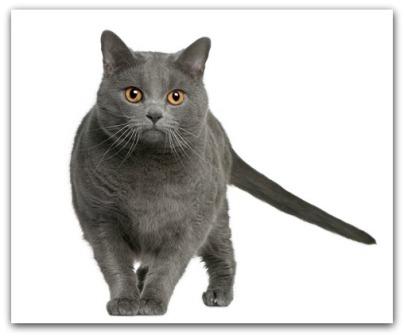
a coat in shades of blue
The coat comes in 1 color only - any shade of unblemished blue-gray, from a slate blue to an ash blue.
The tips of the hairs may be slightly brushed with silver.
The Chartreux cat's coat has a wooly texture and is medium short. The coat has a resilient undercoat and a longer protective top coat.
The woolliness and density of the coat depends on the climate, the sex of the cat and also the age of the cat.
breed features and characteristics
This domestic cat has a robust physique. It is strong-boned, with solid muscles a deep chest and broad shoulders. Its neck is short and heavy-set
Its legs are short, sturdy, but fine-boned and straight. They are fondly described as 'potatoes on toothpicks'.
The tail is medium length and heavy at the base and tapers to an oval tip.
The Chartreux's head is rounded and broad but not spherical. It has full cheeks, a powerful jaw and its muzzle is small and narrow. Ears are erect and set high on the head
The face has a sweet smiling expression.
Eyes are large, round and expressive and the eye-color ranges from gold to copper, but a brilliant orange is preferred.
It's important to note that the American and European breed standards differ for this cat.
info for potential owners
ideal home | ideal family
These cats need space - a safe, enclosed, escape-proof garden would suit them best.
Would they suit a home with children?
They would suit a family with older children. Whilst they are affectionate and sometimes playful, they prefer a quiet environment, need their space and prefer to observe rather than get involved in rough play.
Are they pet friendly?
They are dominant cats which means they would prefer the company of cat-friendly dogs rather than other cats.
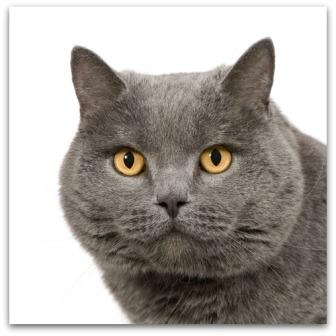
personality and temperament
They are independent, sweet and easy-going companion cats. They have strong personalities and enjoy solitude and tranquility.
They are affectionate, devoted to their owners and wonderful companions to single and older people.
Some owners describe them as lazy cats that prefer to observe rather than participate, but these excellent mousers need only see a mouse to spring into action.
They are robust, hardy cats that are suited to cold climates. They enjoy the outdoors, but too much sun results in brown highlights on their coat.
Whilst these blue cats are skilled hunters, access to the outdoors should be reserved for cooler days.
They have quiet, high-chirping voices, but they do not use their voice in excess.
cat care
Brushing these domestic cat's double coat is NOT recommended.
Simply use a grooming glove or run your fingers through their coat. They are low maintenance cat breeds.
health concerns
Whilst they are robust and healthy breeds, some lines may suffer from:
- Patellar luxation (slipping knee caps)
Always consider cat health insurance for your cat.
diet | average weight
The Chartreux may be sensitive to certain cat foods, especially rich foods.
Older cats do have a tendency to become overweight which will require a low-calorie diet.
Their diet needs to be nutritionally balanced. You have a choice between dry, semi-moist, raw or canned cat food which you can read more about under the cat food chapter. Provide your cat with fresh water daily.
Average Weight of Chartreux Cats
Male cat average weight: 5.0 - 6.8 kg (11 - 15 lbs)
Female cat average weight 2.7 - 4.5 kg (6 - 10 lbs)
life expectancy
These cats have and average life span of 13 - 16 years.
Age is dependent of a number of factors. If your cat receives its annual vaccinations, a well balanced diet, regular exercise and lives indoors, it could live longer than the average age given here. Take a look at 'How long do cats live?' for more great info regarding life expectancy.
Related Pages:
Top of Chartreux Page
Return to Domestic Cats
search our site
please like us
share our site
recommend on google
rare cats
